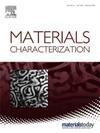Long-term thermal aging effects in ferritic-martensitic steel HT9
IF 4.8
2区 材料科学
Q1 MATERIALS SCIENCE, CHARACTERIZATION & TESTING
引用次数: 0
Abstract
The ferritic-martensitic steel HT9 is a candidate material for fuel cladding and core components in advanced nuclear reactors, such as sodium-cooled fast reactors, thanks to their high temperature mechanical properties and low susceptibility to irradiation induced swelling phenomena. However, thermal stability and elevated temperature microstructural evolution in these alloys may impact their long-term behavior and reliability. In this work, the effects of thermal aging on the microstructural and mechanical properties of HT9 have been investigated through complementary electron microscopy, synchrotron X-ray diffraction, microhardness, and thermodynamic modeling. Plates of HT9 were aged up to 50 kh at relevant sodium-cooled fast reactor operational temperatures (360 °C - 700 °C). Trends in microstructure as a function of aging time and temperature were apparent from qualitative and quantitative analysis. These observations were further supported by thermodynamic modeling of the bulk and precipitate phases. Specific phases observed include BCC Fe, FCC M23C6, HCP and FCC MX phase and Laves M2X phase. Through the application of our multi-scale and multi-modal approach, clear information on the aging mechanism of HT9 was obtained, allowing for a more informed prediction, and understanding of the long-term behavior, performance and thermal stability of ferritic-martensitic alloys exposed to elevated temperatures.
铁素体-马氏体钢 HT9 的长期热老化效应
铁素体-马氏体钢 HT9 具有高温机械性能,不易受辐照诱导的膨胀现象影响,是钠冷快堆等先进核反应堆燃料包壳和堆芯部件的候选材料。然而,这些合金的热稳定性和高温微结构演变可能会影响其长期性能和可靠性。在这项工作中,通过补充电子显微镜、同步辐射 X 射线衍射、显微硬度和热力学建模,研究了热老化对 HT9 的微观结构和机械性能的影响。在相关的钠冷快堆运行温度(360 °C - 700 °C)下,对 HT9 板材进行了长达 50 kh 的老化。通过定性和定量分析,可以明显看出微观结构随老化时间和温度变化的趋势。这些观察结果得到了块状相和沉淀相热力学模型的进一步支持。观察到的特定相包括 BCC Fe、FCC M23C6、HCP 和 FCC MX 相以及 Laves M2X 相。通过应用我们的多尺度和多模态方法,获得了 HT9 老化机制的明确信息,从而可以对暴露在高温下的铁素体-马氏体合金的长期行为、性能和热稳定性进行更明智的预测和理解。
本文章由计算机程序翻译,如有差异,请以英文原文为准。
求助全文
约1分钟内获得全文
求助全文
来源期刊

Materials Characterization
工程技术-材料科学:表征与测试
CiteScore
7.60
自引率
8.50%
发文量
746
审稿时长
36 days
期刊介绍:
Materials Characterization features original articles and state-of-the-art reviews on theoretical and practical aspects of the structure and behaviour of materials.
The Journal focuses on all characterization techniques, including all forms of microscopy (light, electron, acoustic, etc.,) and analysis (especially microanalysis and surface analytical techniques). Developments in both this wide range of techniques and their application to the quantification of the microstructure of materials are essential facets of the Journal.
The Journal provides the Materials Scientist/Engineer with up-to-date information on many types of materials with an underlying theme of explaining the behavior of materials using novel approaches. Materials covered by the journal include:
Metals & Alloys
Ceramics
Nanomaterials
Biomedical materials
Optical materials
Composites
Natural Materials.
 求助内容:
求助内容: 应助结果提醒方式:
应助结果提醒方式:


